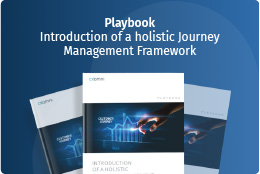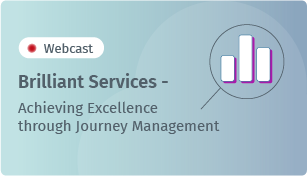What about your customer experience? Are you still visualizing or already managing? The journey map is undoubtedly one of the standard tools of CX teams. However, companies must not get stuck in the cognition process: Only with systematic CX management can customer experiences be actively monitored and controlled. To do this, relevant insights along the customer journey must be discovered, visualized and distributed to those responsible for touchpoints. We explain how this can be achieved and what makes the right mix of strategy and software.
Customer Journey Map vs. CX Management: what are the differences?
The customer journey map visualizes the customer experience. It summarizes it from the first contact with a product or service through the entire usage process. Customer journey maps allow companies to put on customer glasses and identify all touchpoints of their target group by telling and understanding processes from the outside perspective. What’s important is that a journey may begin before the purchase, when customers feel inspiration. And it doesn’t always end with the purchase. Therefore, a visualization should always include the enduring product usage. So CX teams should enrich journey maps with relevant and fresh data. This can be information on unconscious needs and expectations or even disappointments (pain points) during the user’s product usage from surveys, NPS or CSAT queries. In this way, the customer journey provides a comprehensive picture of user behavior and feelings (experience data).
CX management goes one step further. CX management means transforming all relevant information (e.g., survey and workshop results, feedback from focus customers) along the customer journey into recommendations for action (so-called actionable insights) that improve the customer experience at the touchpoint. To do this, the information must be aggregated, processed, and distributed to internal stakeholders. Often, the different scores must also be standardized for comparability. This is not possible without the structure of the customer journey: It forms the logical framework. This way, it is always clear to which touchpoint the information and insights belong and to which department in the company they need to be distributed. This is because insights from the customer journey map only pay off quickly in terms of process improvements at the touchpoint if they reach the right stakeholders. In addition, all insights must be managed: This means prioritizing them according to their relevance to the customer experience and continuously monitoring their processing status – which is the biggest challenge for many CX teams.
Four approaches for a holistic CXM
Depending on the objectives of the CX strategy and the maturity level of the company, four process models are recommended for holistic CX management.
- Collaborative-creative CXM approach: This approach describes the theoretical customer experience at the touchpoint. For this purpose, customer journeys are visualized, hypotheses on customer perception in the case of gains and losses are created, and measures for optimization are defined. This is traditionally done in customer journey mapping workshops.
Structured-sentiment-based CXM approach: Here, the focus is on the changing customer experience. All touchpoints are measurement points where recurring feedback ratings are collected. CX teams can then analyze ratings historically so that statements can be made about the development of customer satisfaction. Here, too, the previously designed or modeled customer journey is accessed. - Process-analytical CXM approach: This approach focuses on the performance of touchpoints along the transaction journey. For this purpose, the actual transaction logs of customer systems such as CRM are analyzed. This allows the definition of the relevant touchpoints and the comparison of their performance from the customer’s point of view with operational target values such as churn rates. So this approach is very much concerned with journey analytics.
- Semantic CXM approach: Here you analyze which topics trigger which sensation in customers at the touchpoint. The basis is formed by feedback statements from sources such as surveys or touchpoint surveys. These statements are sorted according to the topics, statements and feelings they contain and linked to the touchpoints as topic clusters.
All four approaches show: CX management – if it is to be operated holistically and systematically – is an interplay of journey information and feedback data. There is no way around the right software and intelligent data management if companies want to measure and continuously improve their CX performance.
Why the right software makes the difference
But what are the advantages of CXM software and what functions should it have? First and foremost, software ensures more efficient workflows. Here, the status quo of a customer journey is maintained at all times and changes can be implemented immediately and in real time. With whiteboard, Excel or PowerPoint solutions, information is quickly lost.
Especially when working with a lot of information such as customer feedback, touchpoint images or KPIs during journey mapping, database-based software has a clear advantage over flat visualization tools: It guarantees that the touchpoint is created as a database element that can be individually measured depending on the phase, persona and journey, but is only clearly named once in the system and assigned to the corresponding owner. Duplicates are thus ruled out.
More complex customer journeys in particular are based on more data and offer many branches. This complexity can also be managed and mapped more transparently with software.
CX dashboards in particular help with monitoring, as they use KPIs to show at a glance whether customer satisfaction is developing positively or negatively.
Generally speaking, for journey mapping and CX management, the software should enable fast, simple and flexible mapping as well as the integration of customer feedback. Settings and operation are important, as journeys often need to be regrouped or moved. A screensharing feature for collaborative work is also beneficial, as journey mapping and CXM are team efforts. Data connectivity then still needs appropriate APIs: Dan, CX teams can link feedback data streams from survey tools or customer data from a customer data platform to touchpoints. Also look for APIs to project management tools. Because then you can distribute the actionable insights as tickets to stakeholders.
How to convince internal stakeholders
Since journeys can be visualized more easily and clearly than with sketches and sticky notes on the whiteboard, internal stakeholders quickly realize how complex a journey can be. They recognize that they are part of a journey with the touchpoint in their area of responsibility and that they influence the customer’s experience. It also becomes clear more quickly which touchpoints are working well or where there are problems. Interestingly, their own silos then recede into the background and the path to holistic CX management is clear.
Think big, start small
Don’t worry, no one manages the complete holistic approach in one throw. A proof of concept is recommended for the beginning. If this is successful, it is easier to convince internal stakeholders of the added value of holistic CX management. The best place to start is with a pain journey – for example, at a touchpoint where customer churn has been occurring for some time and colleagues may be lacking the right approach to troubleshooting. This increases the commitment of the colleagues – often not without emotions – and you win stakeholders for the project more easily.
Always focus on a use case: What is the goal of better CX? What are the benefits to the customer? And finally, as with any good strategy project, don’t underestimate the time factor: a clear objective, definition of the project structure, and a consistent taxonomy are the key. Then everyone involved in the project knows what it’s all about and can help the proof of concept succeed as a team.







